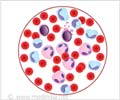A new personalized DNA-based digital assay can detect persistent disease in 81% of samples taken from a group of patients thought to be in remission.

‘Use of a tyrosine kinase inhibitor regimen can lower the blood chronic myeloid leukemia (CML) biomarker to levels imperceptible by current detection methods.’





"If validated in clinical trials of stopping TKIs, this technique will permit a more personalized approach to recommendations for dose reduction or drug cessation in individual patients, ensuring that therapy is withdrawn only from patients with the highest chance of long-term remission," explained lead investigator and head of department Jane F. Apperley, MD, PhD, FRCPath, of the Centre for Haematology, Imperial College (London). Indeed, studies have shown that 60% of CML patients who achieve sustained undetectable levels of BCR-ABL1 transcripts--the hallmark biomarker of CML--experience disease recurrence after TKI treatment is withdrawn. Investigators compared the sensitivity of the new technique, DNA-based digital PCR (dPCR) assay, to three other quantitative PCR methods currently used to measure residual CML, including reverse transcriptase-quantitative PCR (RT-qPCR), quantitative PCR (qPCR), and reverse transcriptase-digital PCR (RT-dPCR). RT-qPCR is currently the most widely used method for monitoring residual disease in CML patients.
Thirty-six samples were taken from six patients with early CML who were thought to be in deep molecular remission, as indicated by RT-qPCR results. Repeat analysis using dPCR with preamplification detected persistent disease in 81% of the samples. In comparison, the detection rate was 25% using RT-dPCR and 19% for qPCR. "We conclude that dPCR for BCR-ABL1 DNA is the most sensitive available method of residual disease detection in CML and may prove useful in the management of TKI withdrawal," stated Dr. Apperley.
The new assay has the potential to dramatically impact CML management. Immediately after CML diagnosis, the patient's genomic breakpoints would be identified, enabling the design of a patient-specific assay. The patient's response to therapy would be monitored using standard RT-qPCR until reaching molecular remission. At that point, routine monitoring would be augmented with dPCR, allowing better-informed treatment decisions and improved patient management.
According to Dr. Apperley, the new method improves on previous methodologies in two key areas. First, dPCR is a DNA-based method that allows identification of BCR-ABL1 fusion junctions by targeted next-generation sequencing. This enables the rapid generation of high-performing DNA-based hydrolysis probe assays that are specific to the individual molecular footprint of each patient's CML clone, although the number and location of fusion junctions may vary among patients.
Advertisement
Source-Eurekalert










